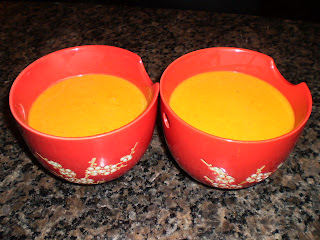Just as my dislike of Christmas is well-known (refer to the blog entry about gingerbread cookies), my love for friends, good times and good food is equally famous. And since the Holidays are supposed to be about sharing, every year I organize a pot-luck for my friends. Everyone brings a little something and we have a great time geeking out.
Obviously, I make cupcakes for that pot-luck. Because I. Have. To. Make. Cupcakes. It's kind of an addictive thing to bake... This year, Sam (who is becoming my muse for the "out of the box" cupcakes) suggested I try to bake eggnog cupcakes. I vaguely remember taking a sip of eggnog from my grandfather's glass when I was little and going "yuck!". But now that I am older, I can appreciate a rich, creamy and boozy nightcap on a cold winter night. I faced a few skeptical eyebrows, but come on! Cream, rhum, nutmeg? Can you really go wrong with those guys?
I was stunned by the quantity of recipes I found researching these. I found this one on Sharyn Carlson's blog, Living Artfully, and it sounded so yummy, I didn't even modify it!
Cupcakes:
1 1/3 cups all purpose flour
1 cup sugar
1/2 teaspoon salt
1/4 teaspoon baking soda
1/2 teaspoon baking powder
1/2 teaspoon ground nutmeg
1/4 cup dark rum
1 cup eggnog (regular, low-fat or soy)
1/4 cup vegetable oil
1 tablespoon apple cider vinegar
1 teaspoon vanilla extract
1 cup sugar
1/2 teaspoon salt
1/4 teaspoon baking soda
1/2 teaspoon baking powder
1/2 teaspoon ground nutmeg
1/4 cup dark rum
1 cup eggnog (regular, low-fat or soy)
1/4 cup vegetable oil
1 tablespoon apple cider vinegar
1 teaspoon vanilla extract
Preheat oven to 350°F and line a cupcake pan with liners. In a large bowl, whisk together the flour, sugar, salt, baking soda, baking powder, and nutmeg. In a separate bowl, combine the rum, eggnog, vegetable oil, apple cider vinegar and vanilla extract together. Add the flour mixture to the wet ingredients and beat just to combine. Fill the cupcake liners. Fill about 2/3 of the way if you want flat cupcakes and 3/4 of the way if you want rounded tops. Bake for about 18 minutes, until toothpick inserted into the center comes out clean. Remove from oven and allow to cool completely.
Frosting:
1/4 cup unsalted butter (or nonhydrogenated margarine), room temperature
2 to 2-1/2 cups confectioner's sugar
3 tablespoons eggnog
2 tablespoons rum
1/4 teaspoon ground nutmeg
2 to 2-1/2 cups confectioner's sugar
3 tablespoons eggnog
2 tablespoons rum
1/4 teaspoon ground nutmeg
In a large bowl, using a stand or electric mixer, whip the butter for a minute or two, until light and fluffy. Slowly add the confectioners sugar, mixing as you add the sugar. Continue adding sugar until the mixture becomes stiff. Add the eggnog, rum and nutmeg, and whip until combined. Frost cupcakes as desired.
I doubled the quantities, because my friends can be just like a swarm of locusts when they get hungry. Better safe than sorry, especially with a few gluttons on the guest-list! The cake turned out moist and chewy. For those who haven't tried, rhum flavored desserts are delightful and extremely tasty.
I was also pleased to see how easily veganized the recipe is, so anyone can enjoy this little Holiday sweet!
I must confess that I got a bit too heavy-handed with the eggnog in the frosting, so it turned a little more runny than I wanted. If you want to have perfect, stiff frosting, keep a close eye on your quantities... but what's the fun of baking if you can't make a sugary, sticky mess? They still looked adorable sprinkled in freshly ground cinnamon.
The verdict was that those cupcakes were were good but very sweet. Since they are full of eggnog and rhum, this is no surprise. My personal opinion was that I preferred the cake to the icing, and that I am greatly looking forward to making rhum-cakes with vanilla icing!
Also, I realized that I love to bake with booze! The little tasty and decadent hints of the rhum you get in every bite was just (for lack of a better word) sexy. I can't wait to make other boozy cupcakes with more alcohols and liqueurs I like.































